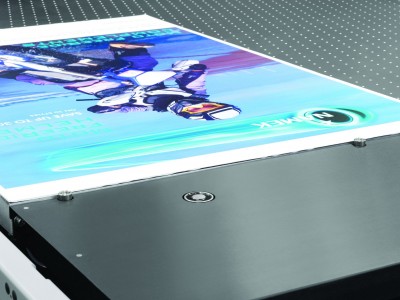New opportunities in graphic applications
by Matthew | 10 September 2012 11:08 am
 [1]
[1]Photo courtesy Imagerie DB
By Xavier Garcia and Kevin McKay
In 2011, worldwide demand for printed graphics drove significant growth within the industry. The resulting boom in digital printing, especially, has pushed more print service providers (PSPs) to capitalize on business opportunities related to new and recent technologies, such as ‘latex’ durable aqueous inks and versatile printers that can handle a wide range of substrates. Much of their current and forecast growth is and will be derived from their digital portfolio.
The ongoing analogue-to-digital conversion of the large-format printing industry, affecting offset print houses and screenprinting operations, is reflected in both the rapid development of high-end digital presses and the growing demand for shorter, more personalized print runs. Today’s industrial digital presses are capable of the same print volumes and quality as in the screenprinting sector, but with faster turnaround times and special applications like variable data printing (VDP). And the average PSP job’s print run has dropped dramatically, from 15,000 to 1,500 copies.
Meanwhile, as brand managers continue to strengthen their corporate social responsibility (CSR) efforts, an increasing number of businesses are taking a sustainable approach to large-format print sourcing. These customers are setting strict environmental requirements for their jobs, which PSPs must meet to win their business.
As such, signmakers are turning to products certified by organizations like the Greenguard Environmental Institute (GEI) for reducing chemical emissions in the interests of indoor air quality (IAQ) and human health. This trend is leading to a decline in solvent-based inkjet printing, concurrent with a rise in latex and other technologies.
For all of these reasons, PSPs are watching technology trends and taking advantage of new graphic applications to make sure 2012 is another year of growth.
 [2]Market penetration
[2]Market penetration
The point-of-purchase (POP) display sector is one of the areas where trends like shorter print runs, faster turnarounds and VDP for personalization are becoming apparent. Through ‘versioning,’ software can facilitate rollovers between seasonal campaigns. While only 20 per cent of retail signage is currently printed digitally, new business opportunities are opening and the number will continue to grow rapidly.
Outside signage, short runs and customization are also taking hold in the corrugated packaging market. Customers’ graphic files can now go straight to production, making it easier, less expensive and faster to produce customized packaging for test markets, short runs of prototypes or colour-consistent free-standing merchandising display units, among other high-value jobs. This process marks an opportunity for shops to gain a competitive edge against others who have not yet converted to digital printing.
Indeed, many shops are achieving success by diversifying beyond their traditional applications and entering new markets, while using the same equipment. Cober Evolving Solutions in Kitchener, Ont., for example, runs sheet-fed presses and produces packaging in high volumes, but has also gotten into wide-format printing. And in turn, grand-format printer users are getting into the corrugate packaging business.
Meanwhile, Greenguard-certified inks open the door to the interior design community, where curtains, pillows, rugs, wallcoverings, doors, ceiling tiles, flooring and furniture can all now be printed. Using water-based latex or ultraviolet-curable (UV-curable) inks, for example, signmakers can print graphics for installation in sensitive environments, including hospitals, school classrooms and children’s bedrooms.
 [3]
[3]Print service providers (PSPs) are capitalizing on new digital systems that can handle a wide range of substrates, including fabrics.
These interior design applications represent a major opportunity for new work, given they are printed today with analogue devices—or not printed at all!
Divide and conquer
In 2011, there was also a polarization of PSPs into two groups. One comprises high-volume graphic producers with highly specialized niche markets. The other category comprises more versatile shops that not only print graphics, but also offer multi-channel marketing services.
As each of these groups finds its place in the new communications landscape, they will both be able to thrive, with the right mix of technology and strategy.
Transitioning for tomorrow
Building on 2011’s growth and transitions, 2012 has been another dynamic year for large-format printing.
‘Cloud computing,’ in particular, is changing how many PSPs do business, as has been witnessed in many other industries, too. Customers are connecting more directly to the digital printing of their graphics, while printer manufacturers are using new workflow software to help optimize productivity and efficiency.
Growth opportunities continue to abound, but especially for signmakers and other PSPs who are willing to increase their offerings and make the most of today’s printing technologies.
Xavier Garcia is general manager (GM) of Scitex, part of HP’s Imaging and Printing Group (IPG), and Kevin McKay is a marketing manager for HP Canada. For more information, visit www.hp.ca[4]/[5]signage[6].
- [Image]: http://www.signmedia.ca/wp-content/uploads/2014/02/A.jpg
- [Image]: http://www.signmedia.ca/wp-content/uploads/2014/02/Latex_textile_flag.jpeg
- [Image]: http://www.signmedia.ca/wp-content/uploads/2014/02/HP+Scitex+FB7600+Industrial+Press+output.jpg
- www.hp.ca: http://www.hp.ca/signage
- /: http://www.hp.ca/signage
- signage: http://www.hp.ca/signage
Source URL: https://www.signmedia.ca/new-opportunities-in-graphic-applications/